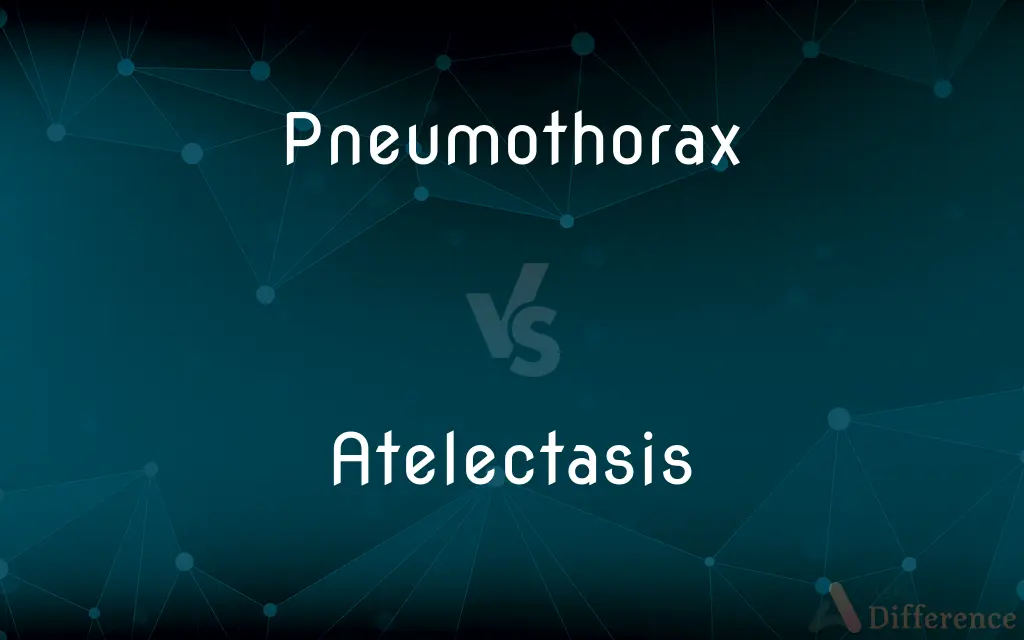Pneumothorax vs. Atelectasis — What's the Difference?
By Maham Liaqat & Urooj Arif — Updated on April 23, 2024
Pneumothorax involves air in the pleural space causing lung collapse, while atelectasis is the collapse of lung tissue due to blocked air passages or external pressure.

Difference Between Pneumothorax and Atelectasis
Table of Contents
ADVERTISEMENT
Key Differences
Pneumothorax occurs when air enters the pleural space, the area between the lung and chest wall, disrupting the lung's ability to expand. Atelectasis, on the other hand, occurs when part of the lung collapses due to obstruction in the airways or because of pressure on the outside of the lung.
Pneumothorax can result from injury or spontaneously without apparent cause, particularly in tall, thin individuals or due to underlying lung diseases. Atelectasis often occurs after surgery, during hospitalization, or because of respiratory blockages, such as mucus plugs.
Symptoms of pneumothorax include sudden chest pain and shortness of breath. Atelectasis may also cause breathing difficulties, but its symptoms can be subtler, sometimes only detected with a chest X-ray.
Treatment for pneumothorax may require procedures to remove air from the pleural space to allow the lung to re-expand, such as needle aspiration or chest tube insertion. Atelectasis treatment focuses on re-expanding the affected lung tissue, often through respiratory therapies and exercises.
Both conditions can be critical, particularly if left untreated, but the immediacy and type of treatment differ. Pneumothorax often requires emergency intervention to prevent complications, whereas atelectasis is managed with ongoing care to improve lung function.
ADVERTISEMENT
Comparison Chart
Definition
Air in the pleural space causing lung collapse
Collapse of lung tissue due to obstruction or pressure
Common Causes
Trauma, spontaneous, lung disease
Surgery, blockage in airways, external pressure
Symptoms
Sudden chest pain, shortness of breath
Mild breathing difficulty, often detected by X-ray
Treatment
Needle aspiration, chest tube
Respiratory therapies, exercises
Urgency of Treatment
Often requires immediate intervention
Managed with ongoing care
Compare with Definitions
Pneumothorax
Associated with lung collapse.
The X-ray showed a collapsed lung, indicating a possible pneumothorax.
Atelectasis
Can result from obstruction or compression.
Atelectasis in children is often caused by inhalation of a small object.
Pneumothorax
May recur in certain cases.
Patients with a history of pneumothorax may experience recurrences, requiring additional surveillance.
Atelectasis
Detected often through imaging.
The chest X-ray revealed atelectasis, which was missed during the physical exam.
Pneumothorax
Requires medical intervention.
Treating pneumothorax might involve inserting a chest tube to remove the air.
Atelectasis
Managed with breathing exercises.
The patient was advised to perform deep breathing exercises to help resolve the atelectasis.
Pneumothorax
Can be spontaneous or traumatic.
Spontaneous pneumothorax often occurs in young, healthy individuals without any chest injury.
Atelectasis
May affect oxygenation.
Severe atelectasis can lead to significant oxygenation problems, requiring supplemental oxygen.
Pneumothorax
Presence of air in the pleural space.
The doctor diagnosed him with pneumothorax after he complained of sudden chest pain.
Atelectasis
Collapse or closure of lung tissue.
Postoperative atelectasis is common in patients who undergo major surgery.
Pneumothorax
A pneumothorax is an abnormal collection of air in the pleural space between the lung and the chest wall. Symptoms typically include sudden onset of sharp, one-sided chest pain and shortness of breath.
Atelectasis
Atelectasis is the collapse or closure of a lung resulting in reduced or absent gas exchange. It is usually unilateral, affecting part or all of one lung.
Pneumothorax
Accumulation of air or gas in the pleural cavity, occurring as a result of disease or injury, or sometimes induced to collapse the lung in the treatment of tuberculosis and other lung diseases.
Atelectasis
The absence of gas from all or part of the lung, due to failure of expansion of the alveoli.
Pneumothorax
(medicine) Presence of air inside the pleural cavity, usually caused by injury either to the lung or the chest wall.
Atelectasis
A congenital condition characterized by incomplete expansion of the lungs.
Pneumothorax
A condition in which air or other gas is present in the cavity of the chest; - called also pneumatothorax.
Atelectasis
(medicine) The collapse of a part of or the whole lung caused by inner factors rather than a pneumothorax.
Pneumothorax
Abnormal presence of air in the pleural cavity resulting in the collapse of the lung; may be spontaneous (due to injury to the chest) or induced (as a treatment for tuberculosis)
Atelectasis
Collapse of an expanded lung (especially in infants); also failure of pulmonary alveoli to expand at birth
Common Curiosities
What are the risk factors for pneumothorax?
Risk factors include smoking, underlying lung diseases, and genetic factors.
What are common symptoms of atelectasis?
Symptoms can include difficulty breathing, rapid breathing, and sometimes coughing.
What is the main difference between pneumothorax and atelectasis?
Pneumothorax is caused by air entering the pleural space, while atelectasis results from airway blockage or pressure on the lung.
Can both pneumothorax and atelectasis occur simultaneously?
Yes, it's possible, especially following chest trauma or in surgical patients.
What are effective preventive measures for atelectasis?
Preventive measures include frequent repositioning, encouragement of deep breathing, and use of incentive spirometry, especially post-surgery.
What is tension pneumothorax?
Tension pneumothorax is a life-threatening condition where air trapped in the pleural space causes significant pressure on the heart and lungs.
How are pneumothorax and atelectasis diagnosed?
Both conditions are typically diagnosed with imaging studies, such as a chest X-ray or CT scan.
How critical is immediate treatment for pneumothorax?
Immediate treatment is crucial for pneumothorax to prevent severe complications, including tension pneumothorax.
Can lifestyle changes help in managing pneumothorax?
Quitting smoking and avoiding high-pressure situations can help reduce the risk of pneumothorax.
Is atelectasis more common in certain age groups?
Yes, it is more common in children due to smaller airways and in elderly patients who are less mobile.
Share Your Discovery

Previous Comparison
Shiesty vs. Sheisty
Next Comparison
Honoured vs. HonoredAuthor Spotlight
Written by
Maham LiaqatCo-written by
Urooj ArifUrooj is a skilled content writer at Ask Difference, known for her exceptional ability to simplify complex topics into engaging and informative content. With a passion for research and a flair for clear, concise writing, she consistently delivers articles that resonate with our diverse audience.














































